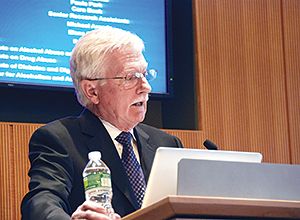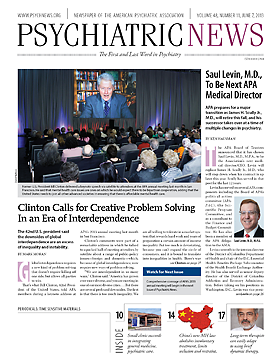Recall for a moment paintings by Degas or Picasso of absinthe drinkers staring glassily into space, minds distant. The images are hardly enticing advertisements for the pleasures of a drug of abuse.
In fact, the subjects’ faces reflect the “Dark Side” of addiction, said George Koob, Ph.D., a professor and chair of the Committee on Neurobiology of Addictive disorders at the Scripps Research Institute in La Jolla, Calif.
The Dark Side arises as hedonic states change with repeated exposure, said Koob, in a talk in March marking the 100th anniversary of the Henry Phipps Clinic at Johns Hopkins.
The more someone with addiction drinks, smokes, snorts, or injects, the less pleasure it brings, Koob contended. The initial pleasure of taking drugs or alcohol is replaced with a higher brain reward threshold as drug use becomes compulsive and the user becomes dependent.
“We see a decrease in reward paralleling compulsive drug-seeking behavior, not the other way around,” he said. “There is not a sensitization of the reward system but a hedonic tolerance.”
During acute withdrawal, reward neurotransmitters are compromised, the reward system becomes quiescent, and the organism loses positive reinforcement, he said.
Koob further elaborated on the role in addiction of corticotrophin releasing factor (CRF), just one of several neurotransmitters recruited in the amygdala during a Pavlovian conditioning state. CRF, a neuropeptide found in the brain, controls glucocorticoids, sympathetic response, and hormonal, autonomic, and behavioral stress responses. The CRF stress system plays a role in the initial transition to dependence and then in sustaining dependence.
“CRF is profoundly changed in the course of the development of drug dependence,” he said. “There are dramatic effects with opiates and alcohol, but not as dramatic with psychostimulants.”
CRF levels rise during withdrawal from all major drugs of abuse, and anxiety-like responses in animal models to all drugs of abuse are reversed by CRF antagonists. Stress-induced reinstatement of drug-seeking behavior can be blocked by CRF antagonists. However, CRF antagonists have no effect on baseline self-administration of drugs or on regular reward behavior but can blunt or block increases in drug self-administration.
“There is a decrease in compulsive self-administration in heroin-dependent animals, but not in nondependent animals,” he said. “So there’s something about compulsive self-administration that involves activation of CRF.”
Treatment with small-molecule CRF antagonists has a “profound effect,” reversing the anxiety-like effect of opiate and alcohol withdrawal, said Koob. “So a CRF antagonist would be really useful as an adjunct for the treatment of drug addiction.”
While a clinical role for CRF antagonists sounds enticing, compounds tested in humans have not yet passed phase 3 clinical trials, said Koob. Drugs exist, but legal issues stand in the way of repurposing their use for human studies. “It’s a slow process,” he said.
Early work with another medication suggests the possible role of another biochemical pathway. Experiments using mifepristone, a glucocorticoid antagonist, during the development of dependence appear to block development of excessive drinking, he said. “So maybe the glucocorticoid system is important in the transition to dependence.”
Ultimately, Koob’s consideration of the Dark Side leads him back to the images of those fin de siȲcle habituȳs of Paris cafes and to what he calls “hedonic Calvinism.”
“The brain’s reward system is a limited resource,” he explained. “You can use it up with a binge on cocaine or heroin or alcohol, or you can enjoy the regular pleasures of everyday life.” ■

